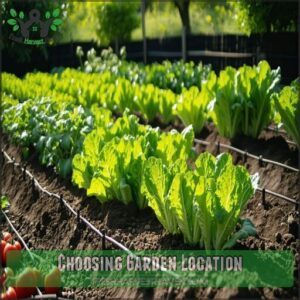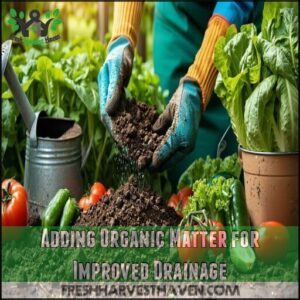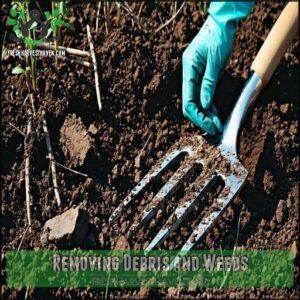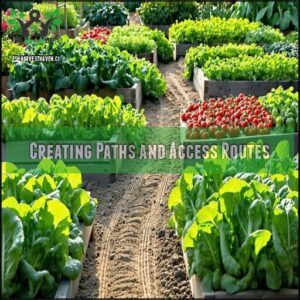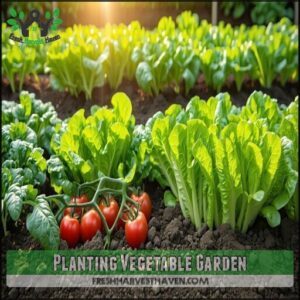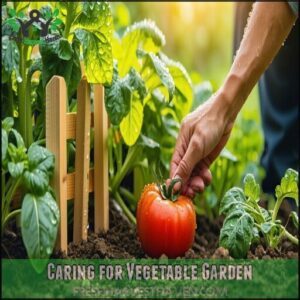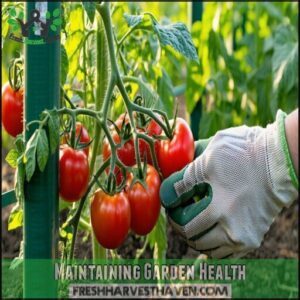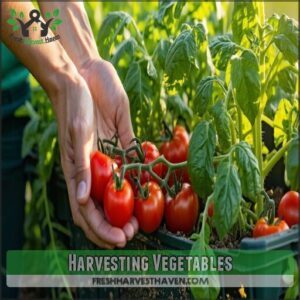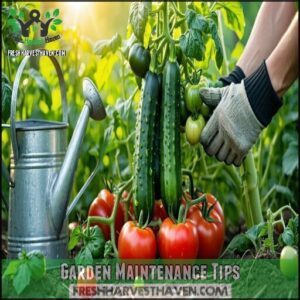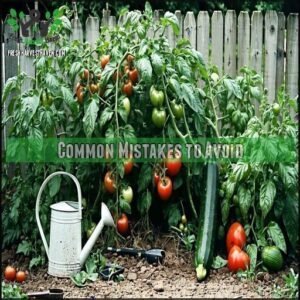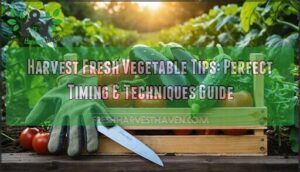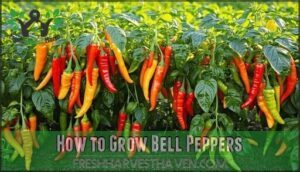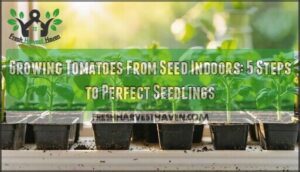This site is supported by our readers. We may earn a commission, at no cost to you, if you purchase through links.
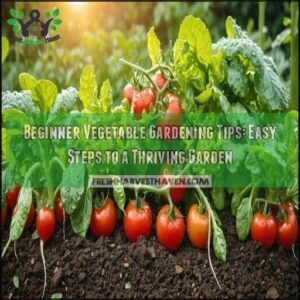 Starting your first vegetable garden? Choose a sunny spot—at least 6 hours of sunlight daily is key. Check your soil. Is it loose and dark? Great! If not, mix in compost for nutrients.
Starting your first vegetable garden? Choose a sunny spot—at least 6 hours of sunlight daily is key. Check your soil. Is it loose and dark? Great! If not, mix in compost for nutrients.
Start small with easy crops like lettuce, radishes, or tomatoes; they’re as forgiving as an old pair of sneakers. Water consistently, but don’t drown your plants—wet roots can lead to problems.
Spacing matters too, so don’t crowd them like a packed elevator. Add mulch to keep the soil happy and weeds away. With patience and practice, you’ll grow veggies that taste better than anything in the store—promise!
Table Of Contents
- Key Takeaways
- Choosing Garden Location
- Selecting Vegetables
- Preparing Garden Soil
- Planning Garden Layout
- Planting Vegetable Garden
- Caring for Vegetable Garden
- Maintaining Garden Health
- Harvesting Vegetables
- Garden Maintenance Tips
- Common Mistakes to Avoid
- Frequently Asked Questions (FAQs)
- Can a beginner start a vegetable garden?
- Which vegetables are best for a beginner to grow?
- How do I learn vegetable gardening?
- How should I plan a vegetable garden?
- What should a beginner vegetable gardener look for?
- What should I consider before planting a vegetable garden?
- What is the easiest vegetable to grow for a beginner?
- What vegetables should not be planted next to each other in a garden?
- What are 5 things you should do to prepare a good veggie garden?
- What is the first thing I should plant in my garden?
- Conclusion
Key Takeaways
- Pick a sunny spot with 6-8 hours of sunlight and well-draining soil to set your garden up for success.
- Start small with easy-to-grow veggies like lettuce, radishes, or tomatoes, and water consistently without overdoing it.
- Add compost to enrich soil, keep weeds in check with mulch, and space plants properly for better growth.
- Rotate crops yearly, pair compatible plants for natural pest control, and monitor for pests or diseases to keep your garden thriving.
Choosing Garden Location
Your garden’s location is key to its success, so pick a spot with plenty of sunlight, good soil, and easy access to water.
A sunny spot with rich soil and water access is the secret to a thriving, happy garden.
Avoid placing it in a windy area or where puddles form—your plants will thank you!
Assessing Sunlight and Shade
Finding the right garden sunlight is key! Most veggies need 6 to 8 sunlight hours daily.
For beginners:
- Southern Exposure: Maximize light by choosing a sunny location.
- Partial Shade: Grow shady vegetables like spinach or lettuce here.
- Use a Garden Sunlight Tool: Track light requirements easily.
- Observe Your Yard: Note sunlight duration before selecting your planting location.
Some vegetables thrive with only partial sunlight.
Evaluating Soil Quality and Drainage
Good soil makes happy plants, so check your soil quality before digging in.
Test soil texture by squeezing a handful—too sandy or too sticky means trouble. Perform drainage testing by pouring water into a hole; it should drain within hours.
Test pH balance and nutrient deficiencies using a soil testing kit.
Add organic content for nutrient-rich soil during garden soil preparation to ensure happy plants.
Considering Wind and Accessibility
Think about wind protection and easy garden access when planning your beginner vegetable garden.
A windy spot can stunt plants, so choose a calm area or add a windbreak like a fence or shrubs.
For accessibility, verify nearby water access, tool storage, and paths with sturdy materials like gravel or mulch.
These garden planning tips save effort and frustration.
Selecting Vegetables
When choosing vegetables for your garden, start with ones that are easy to grow and fit your space.
Think about what your family actually eats, so you don’t end up with a mountain of zucchini nobody wants.
Easy-to-Grow Vegetables for Beginners
A great first step after choosing your garden’s location is picking beginner vegetables that are easy to grow.
These options offer quick harvests, minimal maintenance, and high yields—perfect for new gardeners.
| Vegetable | Growth Time | Sunlight Needed | Ideal Soil | Fun Fact |
|---|---|---|---|---|
| Radishes | 20-30 days | Full sun | Loose, well-drained | Fastest to harvest! |
| Lettuce | 40-50 days | Part shade | Moist, fertile | Grows in containers! |
| Green Beans | 50-70 days | Full sun | Well-drained | Climbs when trellised! |
| Spinach | 35-45 days | Part shade | Loamy, rich | Loves cool weather! |
| Zucchini | 42-50 days | Full sun | Rich, well-drained | Abundant producer! |
Starting a garden is rewarding when it’s simple—stick to easy vegetables to grow, and success will feel like a snap!
Choosing Productive and Popular Varieties
Select high-yield varieties like tomatoes or zucchini for abundant harvests.
Opt for disease-resistant plants to avoid beginner gardening mistakes. Compare heirloom vs hybrid seeds—heirlooms offer flavor, hybrids resist pests.
Include space-saving choices like bush beans or compact peppers for small gardens. Adapt vegetable selection to your region for success.
Easy vegetables to grow make starting out fun and frustration-free.
Considering Family Preferences and Dietary Needs
When picking vegetables, focus on family favorites to keep mealtime exciting.
Grow what you love to eat—it’s the secret to a garden that feeds both your plate and your heart.
Think about dietary restrictions—zucchini’s great for gluten-free noodles or spinach for iron-rich diets.
Let kids help choose; they’ll eat what they grow. Plan recipes ahead to reduce waste and grow what you’ll actually use.
For beginners, lettuce, carrots, and beans are easy vegetables to grow and super versatile.
Preparing Garden Soil
Getting your garden soil ready is like setting the stage for a great performance—it’s where the magic begins.
Remove weeds and mix in compost or other organic matter to create a nutrient-rich, well-draining base that your plants will love.
Adding Organic Matter for Improved Drainage
Improving soil drainage starts with organic amendments like compost or aged manure.
These boost soil aeration and retain nutrients, making your garden a perfect home for thriving vegetables.
Spread a layer of organic matter, about an inch thick, and mix it in well.
You can purchase garden supplies to help with this process.
Think of it as adding vitamins to your soil—it’s how you create fertile, nutrient-rich soil for happy plants!
Removing Debris and Weeds
After adding organic matter, it’s time to clear the area.
Removing debris like rocks or sticks keeps roots happy, while pulling and composting weeds stops garden pests in their tracks.
Use hand tools or hoes for fast weed control—your soil preparation depends on it.
Prevention methods like mulching boost long-term weed management, saving time and effort later, which is crucial for effective garden maintenance.
Planning Garden Layout
Planning your garden layout helps you make the most of your space and keeps everything organized.
With a good plan, you can avoid overcrowded plants, create easy-to-reach paths, and even leave room for those perennials that just keep coming back, which is crucial for a well-organized garden to thrive and for you to enjoy the perennials.
Determining Garden Size and Shape
Start small when planning your vegetable garden. A manageable plot size, like 6×6 feet, avoids overwhelming yourself.
Estimate garden dimensions based on your space calculation and plan for garden layout flexibility. Beginner limits are key—include perennial planning for crops like herbs.
Think about path inclusion early to avoid stomping on soil while tending your plants.
Creating Paths and Access Routes
While planning your vegetable garden layout, make paths practical and pretty.
Paths prevent soil compaction and help you reach plants with ease.
Here’s how to create effective garden paths:
- Path Materials: Use gravel, mulch, or stepping stones for easy upkeep.
- Accessibility Needs: Make paths wide enough for tools or wheelbarrows (18-24 inches).
- Maintenance Requirements: Lay weed barriers to minimize unwanted growth.
Allocating Space for Perennial Crops
When creating paths, save room for perennial crops like asparagus, herbs, or a berry patch.
Think long-term—these plants stick around, so give them a sunny spot with good drainage. Keep them near permanent structures like fences for support.
Planning an herb garden or fruit trees? Place them thoughtfully to avoid shading your veggies.
Smart vegetable garden planning guarantees lasting rewards, which is the key to a successful and thriving garden!
Planting Vegetable Garden
Planting your vegetable garden is all about giving your plants the best start with good spacing, smart watering, and a little care.
Don’t worry if you’re new—just follow a few simple steps, and you’ll be harvesting fresh veggies in no time, with good spacing being key to their success.
Starting Seeds Indoors or Direct Sowing
Growing vegetables from seed gives you two solid options: direct sowing or starting indoor seedlings.
Direct sowing is simple—place seeds directly in warm soil, ideal for crops like carrots.
Indoor seedlings offer control over seed germination but need transplanting outdoors with seedling hardening.
High-quality seeds and proper planting dates boost germination rates.
Choose based on your time and resources! Many gardeners find success using seeds for direct sowing.
Spacing and Arranging Plants for Optimal Growth
When arranging plants, think about their proximity to each other.
Crowding reduces sunlight access and air circulation, leading to unhappy vegetables.
Use beginner tips like spacing seeds based on packet instructions.
Companion planting pairs plants with mutual benefits, while vertical gardening saves space for climbers like beans or cucumbers.
Consider square foot gardening to maximize yield in a limited area.
Smart garden planning keeps everything thriving and easy to maintain, utilizing techniques like companion planting and maximize yield to ensure a healthy garden.
Watering and Mulching Techniques
After arranging your plants, focus on keeping them hydrated.
Water your vegetable garden early in the morning for deep soil moisture, preventing evaporation.
Use mulch types like straw or wood chips to lock in moisture, suppress weeds, and boost water conservation.
Beginner vegetable gardening thrives with consistent watering techniques—stick your finger in the soil to check if it’s thirsty, which is a simple yet effective way to ensure your garden stays healthy with proper hydration.
Caring for Vegetable Garden
Taking care of your vegetable garden is all about keeping plants healthy and productive, and it’s easier than you think.
With the right watering, pest control, and support for growing plants, you’ll soon enjoy fresh, homegrown veggies without the stress, and this is all about productive gardening.
Fertilizing and Pest Control Strategies
Feeding your garden is like cooking a great meal—use organic fertilizers to enrich soil health without overdoing it.
Keep pests at bay by handpicking bugs, spraying aphids off with water, or planting companion plants like marigolds.
Need extra protection? Natural pesticides work wonders. You can find organic soil amendments for healthier plants. Fertilizing vegetables and pest control go hand in hand for thriving, nutrient-rich soil and healthier harvests.
Monitoring for Common Problems and Diseases
Watching over your garden helps you spot gardening challenges early.
Check leaves for spots or yellowing—signs of disease or nutrient deficiencies. Look under leaves for pests like aphids.
Keep an eye on plant health monitoring regularly to catch issues fast.
Use organic solutions like neem oil for pest control, and remove affected plants to prevent garden diseases from spreading.
Providing Support for Climbing Plants
Supporting climbing plants keeps your garden organized and productive.
Use trellis types or natural supports like fences to guide growth. Staking methods work well for tomatoes and beans.
Secure plants gently with plant ties to avoid damage. Remember to prune climbers regularly for better airflow and healthy growth.
These gardening tips guarantee your climbing varieties thrive in your planting schedules.
-
Try these ideas:
- Trellises for support
- Staking for stability
- Natural supports like fences
- Plant ties for securing
- Pruning climbers
Maintaining Garden Health
Keeping your garden healthy means staying one step ahead of pests, diseases, and weeds.
By rotating crops, pairing the right plants together, and tackling weeds early, you’ll keep your plants strong and thriving.
Rotating Crops for Soil Health
Rotating crops boosts soil health by preventing nutrient depletion, breaking pest cycles, and reducing soilborne diseases.
Keep it simple—change crop families each season. For example, follow tomatoes with beans to restore nitrogen.
Toss in some green manure like clover to create nutrient-rich soil. This organic vegetable gardening trick keeps your garden thriving and makes you feel like a soil expert! It utilizes a simple yet effective method to improve soil health, making it a great organic vegetable gardening trick.
Using Companion Planting for Pest Control
Companion planting is a clever way to outsmart pests.
Use pest-repelling plants like marigolds to deter nematodes or basil to ward off whiteflies.
Attracting beneficials like ladybugs with dill and fennel brings natural pest control.
Trap cropping lures pests away from key veggies, and a companion planting chart helps plan, offering natural pest deterrents and organic vegetable gardening benefits in one swoop!
Managing Weeds and Preventing Pests
Pull weeds regularly to keep soil healthy and prevent pests from settling in.
For organic weed control, try mulch or hand weeding. Natural pest repellents like neem oil or garlic spray work wonders.
Attract beneficial insects, like ladybugs, for pest management. Companion planting, such as marigolds near tomatoes, acts as a natural pest deterrent.
Stay consistent with garden maintenance and use natural pest repellents to ensure a healthy garden.
Harvesting Vegetables
Harvesting your vegetables at the right time guarantees they taste their best and stay fresh longer.
Don’t wait too long, or you might end up feeding the critters instead of your family!
Understanding Harvest Timing and Techniques
You’re almost there—harvesting is the fun part! Watch for peak maturity by checking harvest indicators like size, color, and firmness.
Staggered planting means less guessing and fresher veggies.
Use proper tools, like a garden harvesting tool or sharp shears, to avoid damaging plants.
Handle with care, and don’t wait too long, or taste and texture may suffer!
Storing and Preserving Harvest for Longevity
Once you’ve mastered harvesting vegetables, focus on garden storage. Keep your garden harvest fresh with cool, dark spots or root cellaring for carrots and potatoes.
Try preserving with canning techniques, freezing produce, or drying methods. Understanding peak ripeness indicators guarantees you’re preserving vegetables at their best.
Fermentation basics work wonders for unique flavors. Check stored crops regularly for spoilage—your effort keeps those summer flavors alive all year with proper preservation and regular checks to ensure the best summer flavors.
Identifying and Treating Pests and Diseases
Pests and diseases can sneak in like uninvited guests at a party.
Spot signs like yellowed leaves, holes, or strange spots. Identify pests early, and welcome helpers like ladybugs for natural control.
Organic solutions like neem oil fight plant diseases while staying eco-friendly.
Rotate crops, practice good garden protection, and stick with organic practices to keep plant health strong.
Garden Maintenance Tips
Keeping your garden thriving is about consistent care, not perfection.
With a little planning for watering, pruning, and tracking growth, you’ll stop problems before they start and keep plants happy all season.
Watering and Irrigation Strategies
Water your vegetable garden early in the morning to reduce evaporation and keep plants hydrated. Check soil moisture before watering—soggy soil isn’t helpful.
Drip irrigation saves water and meets plants’ watering needs efficiently. For simplicity, try automated systems or hoses with timers.
Adjust watering frequency during heatwaves, but remember, overwatering wastes water and stresses plants.
To improve moisture retention, consider using organic mulch effectively. Keep it balanced!
Pruning and Training Plants
Pruning and training plants might feel intimidating, but it’s easier than you think.
Smart pruning techniques keep plants healthy and productive.
Use these gardening tips:
- Remove dead or overcrowded branches to improve air circulation.
- Use plant support like stakes or trellises to guide growth with simple training methods.
- Prune early morning, when plants are hydrated and perky.
Keeping a Garden Notebook or Journal
A garden notebook keeps you organized and on top of your gardening journey.
Jot down planting dates, tracked varieties, and pest control tips.
Record weather patterns and harvest records to spot trends.
A gardening calendar or digital garden planner helps map out your planting schedule.
It’s like a diary for your garden—without the teenage drama, and using a gardening calendar can be very helpful.
Common Mistakes to Avoid
It’s easy to make a few rookie mistakes that could leave your garden struggling instead of thriving.
Don’t worry though—avoiding common pitfalls like overwatering, skipping soil prep, or planting in the shade can set you up for success.
Overwatering and Underwatering Plants
Too much or too little water spells trouble for plants.
Overwatering causes root rot, while underwatering leads to wilting.
Check soil moisture before watering.
- Stick your finger into the soil; if it’s dry 1-2 inches down, water.
- Make certain proper drainage solutions to prevent soggy roots.
- Adjust watering frequency for weather—hot days need more garden irrigation.
Insufficient Sunlight and Soil Preparation
Don’t underestimate sunlight needs—vegetables thrive with 6-8 hours of direct sunlight.
Place shade-tolerant crops like lettuce in partial sun spots.
Poor garden preparation also hurts plants. Test soil with a kit to verify proper pH, and fix drainage issues before planting.
Add organic amendments like compost for nutrient-rich soil. Healthy garden soil makes all the difference!
Not Rotating Crops and Using Companion Planting
Skipping crop rotation and companion planting can leave your soil overworked and your veggies vulnerable.
Rotate crops yearly to restore nutrients and prevent pests. Use companion planting to naturally boost growth and deter bugs—try marigolds to ward off aphids or basil near tomatoes for flavor and protection.
- Rotate crops to enrich soil.
- Pair plants for pest control naturally.
- Increase yields by diversifying.
Frequently Asked Questions (FAQs)
Can a beginner start a vegetable garden?
Why not get started?
Starting a vegetable garden is easier than you think.
Begin small with simple crops like lettuce and tomatoes, pick a sunny spot, prep the soil, and enjoy the rewards—fresh, tasty veggies!
Which vegetables are best for a beginner to grow?
Start with easy veggies like lettuce, radishes, and green beans—they grow fast and need little fuss.
Tomatoes and zucchini are also great if you want bigger harvests.
Choose what you love to eat!
How do I learn vegetable gardening?
To learn vegetable gardening, start small with easy crops like lettuce or radishes.
Watch gardening videos, read beginner guides, and track your progress in a journal.
Practice patience, and don’t be afraid of getting your hands dirty!
How should I plan a vegetable garden?
Pick a sunny spot, plan manageable raised beds or rows, and choose easy-to-grow vegetables.
Sketch your layout, group plants by sunlight needs, and leave space for paths.
Keep it simple, and enjoy the process!
What should a beginner vegetable gardener look for?
For beginners, find a sunny spot with 6-8 hours of light, well-draining soil, and nearby water.
Keep it small (around 6×6 feet) to avoid overwhelm.
Choose easy veggies like lettuce, radishes, or beans.
What should I consider before planting a vegetable garden?
Choose a sunny spot with good drainage and easy water access.
Test soil pH, enrich it with compost, and avoid windy areas.
Plan a manageable size, stick to vegetables you’ll enjoy, and consider companion planting.
What is the easiest vegetable to grow for a beginner?
Lettuce, green beans, and radishes are your perfect trio for starting out.
They grow quickly, take little effort, and reward you with fresh, tasty results.
Plus, they won’t leave you second-guessing your green thumb!
What vegetables should not be planted next to each other in a garden?
Avoid planting beans near onions or garlic—they don’t get along and can stunt each other’s growth.
Keep cucumbers away from potatoes, and don’t place tomatoes near corn, as pests love both.
What are 5 things you should do to prepare a good veggie garden?
Think you can’t grow veggies?
Start small! Pick a sunny spot, test and amend soil with compost, plan crops you love, space plants smartly, and water regularly.
Gardening’s easier than you think—dive in!
What is the first thing I should plant in my garden?
Start with lettuce or radishes—they’re quick, forgiving, and easy to grow.
Lettuce thrives with minimal effort, while radishes mature in just a few weeks, giving you a satisfying, almost instant reward for your gardening efforts.
They provide a satisfying experience, allowing you to see the results of your labor quickly.
Conclusion
Picture your garden as a blank canvas, with each vegetable a brushstroke of flavor and nutrition.
Starting small and following these beginner vegetable gardening tips will help you build confidence and enjoy the process.
Remember to stick with easy crops like lettuce or tomatoes, water wisely, and give your plants plenty of space and sunlight.
With patience and care, you’ll create a thriving haven of fresh veggies that tastes better than anything store-bought.
Now, dig in!

